The Decade of Centenaries: A Reflection
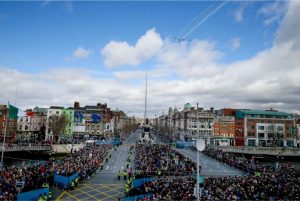
By John Dorney
The ‘decade of commemorations’, the series of hundred year anniversaries of the momentous events that marked the independence struggle and partition of Ireland 100 years ago, is over.
It has been a strange process, in some ways, a mixture of exhilaration, frustration, discord, togetherness and division. At times it felt as if we were, in a sense, expected to relive the revolutionary decade as well as commemorate it.
For those of us who work on modern Irish history, as well as the greater number who are interested in it, the Decade has provided an unprecedented and probably never-to-be repeated opportunity to re-examine those seminal events and to bring them to the attention of the general public.
How has the Decade impacted upon public understanding of Irish history and even Irish identity? How has the feverish flurry of new scholarship changed our perceptions of that time?
If, furthermore, the events of 1912-1923 were crucial in the formation of modern Ireland, the years 2012 to 2023 were also not unimportant ones. Discussion of the Decade of Commemorations and its legacy cannot avoid talking about the present and near past and the context in which Ireland’s revolutionary decade was commemorated.
Reconciliation or discord?
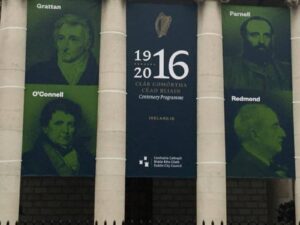
The decade opened with commemoration of the Home Rule crisis and the First World War in 1912-14. In a way in some sense reminiscent of the Redmondite thesis of that time, the discourse around the opening of the centenaries was centred around the idea of shared history and reconciliation.
Just as John Redmond once suggested that Home Rule would create ‘an Ireland of equals’ and that Irish participation in the First World War would forge unity of affection among nationalists and unionists, so similar themes were suggested from 2012 to 2014.
Just as, a century before, however, such hopes underestimated the entrenched differences in views and historical understanding between Irish nationalists, of whatever hew, and Ulster unionists. While the latter were open to the commemoration of the Ulster Covenant and the 36th Ulster Division, there was little real commonality, even one hundred years later, between them and the neo-Home Rulers, who pined for an alternative past in which enmity between those with rival national aspiration could have been overcome within the framework of Irish self-government.
Even in 2016, with the anniversary of the Easter Rising in Dublin the Irish government displayed a marked preference for this narrative, displaying for instance, in central Dublin a banner representing constitutionalist leaders Grattan, O’Connell, Parnell and Redmond rather than the insurrectionists of Easter 1916. This and an anodyne television advertisement promoting ‘reconciliation’ and featuring among other things, the Irish rugby team, provoked one of what turned out to be a series of mini-rebellions against the tone of official commemorations.
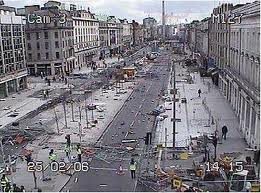
These came to a head in early 2020 when then Minister for Justice Charlie Flanagan proposed an official commemoration for members of the Royal Irish Constabulary and Dublin Metropolitan Police who were killed during the War of Independence. This proved a step too far for mainstream Irish nationalist opinion.
It was one thing to recognise and commemorate those who had died in British uniform during the First World War, but quite another to honour those who had died defending British rule in Ireland. The proposal sparked fierce invective in both mainstream and social media and amid fears of disorder, was eventually cancelled.
Government fear of such disorder was a recurrent theme in the official commemorations. Set piece occasions, particularly on Dublin’s main throughfare, O’Connell Street, were carefully policed. Sometimes this was particularly incongruous, as in the case of the 2013 commemoration of the great strike and Lockout of 100 years before which recreated a baton charge and riot on that same street but which could only be viewed by those vetted by a Garda and private security cordon. Perhaps this caution was caused by fears that the commemorations would awake dormant nationalist passions, as some believe the supposedly ‘triumphalist’ 1966 commemoration of the 1916 Rising did, contributing, so it is argued, to the outbreak of conflict in Northern Ireland in the late 1960s.
Or perhaps it was something deeper; a feeling that disorder lay just under the surface of Irish society at all times. The case for which was demonstrated for instance in riots in Dublin in 2006 on the occasion of proposed loyalist march down O’Connell Street or, violent disturbances in November 2023, at the tail end of the Decade, on that same street, in reaction to a knife attack on children in nearby Parnell Square by a man of Algerian origins.
Locked down
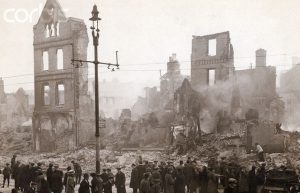
The almost two year lockdown of the country from March 2020 until early 2022 due to the Covid 19 pandemic all but wiped out in-person commemorations for the following two years.
This was perhaps, from an official point of view, just as well, as these years took in the most violent and controversial events of the Irish War of Independence such as the Kilmichael ambush, 1920’s ‘Bloody Sunday’ and the burning of Cork city by Crown forces.
In the wake of the British decision to leave the European Union in 2016, diplomatic relations between the Irish and British governments deteriorated sharply. Though the Dublin government lobbied hard and ultimately succeeded in preventing the re-emergence of ‘hard border’ on the island of Ireland, it did not wish to stoke animosities further by evoking memories of armed conflict with the British, even one 100 years ago.
Despite the absence of physical commemorations, many heated conversations took place, online and elsewhere, on the topic of the legitimacy and utility of political violence both in the 1920s and subsequently. These took on an added significance after the general election of 2020 in which Sinn Fein, the party which had emerged from the Provisional Republican movement, became, for a time the most popular party in the Irish state.
As it was, the lockdown, which included Garda checkpoints preventing people from travelling more than five kilometres from their home, the shuttered shops and empty streets, eerily evoked echoes of the martial law of 100 years before. An RTE television documentary on 1920’s Bloody Sunday, for instance, effectively evoked such parallels visually.
Interestingly, the anniversary the Civil War of 1922-23, which might have been expected to produce the most heat and anger, south of the border at least, seemed to pass off with relatively little fanfare or acrimony.
Sinn Fein, keen to claim the mantle of the independence struggle, did not noticeably show an enthusiasm in adopting the mantle of the anti-Treaty fighters of 1922 or denouncing the ‘Free State’ as previous generations of republicans would undoubtedly have done. Those who did make such connections, such as newly elected TD for Waterford, David Cullinane, who told supporters after Sinn Fein’s election success in early 2020 that ‘we broke the Free State’ were swiftly rebuked by the party leadership.
The commemoration of seminal events such as the shooting of Michael Collins were conducted jointly between the so-called ‘civil war’ parties of Fianna Fail and Fine Gael, now in a governing coalition together. These, again, were very much centred on the theme of reconciliation.
And aside from the somewhat tiresome resurrection of various conspiracies as to how Michael Collins met his end, the Civil War’s anniversary seemed to produce little public debate, let alone discord.
Exhaustion?
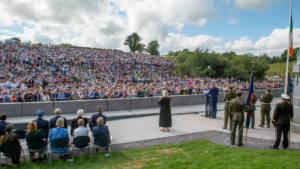
Instead, just as in the events themselves, the public in 2022 and 2023 began to evince increasing exhaustion with the seemingly never-ending centenaries, particularly, as in the case of the Civil War, there seemed to be no clear happy ending or even inspiring defeat.
Similarly, the centenary of the founding of Northern Ireland and its attendant violence seemed to inspire little enthusiasm, even from unionists.
The Irish president Michael D Higgins did, however, create something of a stir by refusing to attend a service marking the birth of the Northern state. For unionists, one senses, unlike the great symbolic events such as the defiance of Home Rule 1912-14 or their own ‘blood sacrifice; in the Great War, there was nothing much to celebrate in the suppression of the nationalist minority as well as the IRA and its campaign in 1920-22. There was a Northern Ireland Office historical advisory panel in parallel to the one south of the border, but it failed to catch public attention during the decade to the same extent.
In the case of Northern nationalists however, one effect the Decade seems to have had has been the re-opening of research on the violence referred to as the ‘Pogrom’ by Northern Catholics, in Belfast in 1920-22. Scholars such as Kieran Glennon and others have done much to illuminate this dark story, previously subsumed, one senses, under the memories of the post 1969 conflict in Northern Ireland.
The end of revisionism?
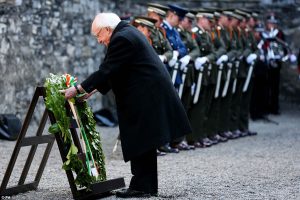
If the summary above may give the impression that the Dublin government commemorated the Irish revolutionary decade reluctantly, this is a half truth.
Certainly, political figures were nervous of any perceived glorification of violence. But at the same time the government poured many millions of euros into commemoration via local groups, national conferences and archives.
The digitisation of such resources as the Bureau of Military History and Military Service Pension Collection at the Military archives, all now online for free, represents a public history resource perhaps unique in the world.
Every county and local authority area was given funding for a Historian in Residence at stages of the Decade and there was also a well-funded schools programme to coincide with the 1916 centenary.
What has been the result of such a huge programme of public engagement? At this point it is difficult to say. Anecdotally however, public understanding of history appears to have returned to a more traditional nationalist understanding of the past. The trends collectively termed ‘revisionism’, which came out of the 1980s and 90s, that sought to downplay the coherence of the Irish nationalist narrative and to de-glamourise the romanticism of political violence found little public endorsement during the Decade.
Such voices still exist of course, but with nowhere near the same prominence as previously. Such anti-republican commentators as Eoghan Harris and Kevin Myers, for instance, so mainstream in their criticism not only of the Provisional IRA but also of the IRA in the War of Independence, as recently as the 2000s and 2010s, became increasingly marginalised in public discourse.
At an academic level there has been no real heir to Peter Hart or David Fitzpatrick, who argued that armed revolution in Ireland violently derailed what should have been a peaceful and amicable route towards Irish self-government. Nor of historians such as Tom Garvin who portrayed the Civil War as a struggle between pro-Treaty democrats and anti-Treaty dictators.
This may be explained by other factors of course – such as fading memories of the more recent Northern Ireland conflict. How this has affected the rise of Sinn Fein as a political force remains an open question. Did the party benefit from the celebration of revolutionary republican heritage or was the endorsement of such heritage itself an expression with dissatisfaction with the establishment response to issues such as housing shortage and cost of living?
Certainly the sight of the Wolfe Tones, a band that has played rebel songs since the 1960s (and whose ‘Celtic Symphony’ features a chorus ‘ooh ah up the ‘Ra [IRA]) featuring at the Electric Picnic music festival, seemed to signal a cultural shift. Their appearance at the Electric Picnic in 2023, which caused a minor media controversy over apparent endorsement of political violence by a generation too young to remember it, would have been difficult to imagine in previous generations.
Apparently the aging Wolfe Tones can be regarded now by young people as harmless nod to their heritage as well as expressing a vague anti-establishment edge. In previous decades, the ‘Tones’ certainly had a following, but were seen by mainstream youth culture as somewhat embarrassing reminder of an uncomfortable and unfashionable past, compared to say bands like U2, Sinead O’Connor or the Cranberries.
While the apparent demise of revisionism may be a source of satisfaction to some, one hopes that it does not lead to an end to asking hard questions of our history.
A new nationalism?
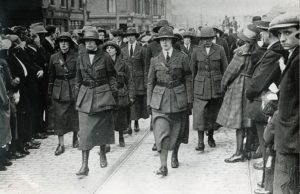
Generally speaking, where it has been used for political purposes, the heritage of revolutionary period has been interpreted as the ‘unfinished revolution’ which promised liberty and equality but was stifled at birth by partition and Civil War.
The women, particularly, of Cumann na mBan and elsewhere have been in particular focus, and their memory was enlisted by some for such contemporary causes as removing the ban on abortion from the Irish constitution – which was removed after a referendum in 2018.
What has probably not received due attention, during the Decade has been the conservative, religious outlook of many of its figures, quite a few of whom served in government in the opening decades of Irish independence. Even, for instance, republican martyr Liam Mellows, executed by the Free State in 1922 and author of left wing pamphlets from prison, was intensely religious in his private life. As indeed were most of the women of Cumman na mBan.
An increasingly secular generation of Irish people finds the attitudes of such people difficult to understand.
And there remains a final point to ponder. As the Decade came to close, nationalism of another sort began to rise in Ireland, in opposition, particularly, to immigration. While generally such groups appear to have absorbed their ideology from a wider, internet-centred milieu, one wonders if they too are, in part, the result of a resurgent nationalist understanding of Irish history.
Certainly, their slogan ‘Ireland belongs to the Irish’ was one that was known in early twentieth century Ireland as a separatist rallying cry – in fact it was coined by Patrick Pearse himself. On the other hand, left-republican groups have been among those attempting to shut down the nascent anti-immigration protests in Ireland – leading to the spectacle of scuffles between two groups both carrying the Republican tricolour and claiming to represent the authentic visions of Irish patriotism.
What is the future of Ireland’s past? Or, to put it another way, how will future generations see Ireland’s early twentieth century struggle for independence? In truth, like all historical narratives it will depend on the needs and priorities of the present.
Perhaps the trajectory of Brexit will drive a deeper wedge between Ireland and Britain, leading to a resurgent nationalism which will place the revolutionary years as its emblem. Perhaps a future united Ireland will see a re-examination of the positive aspects of British rule in an effort to reconcile with Ulster unionists. Perhaps Ireland’s revolutionary heritage will be claimed by those who seek to keep out immigrants, whom they have taken to depicting as a ‘new plantation’. Or perhaps future generations in Ireland, many of whom will have their origins elsewhere, simply will not care.
All of these possibilities and others are open. Future historians of Ireland may reflect on the 2012 to 2023 commemorations as a beginning or conceivably, as an end.
If you enjoy the Irish Story and wish to support our work, please considering contributing at our Patreon page here.